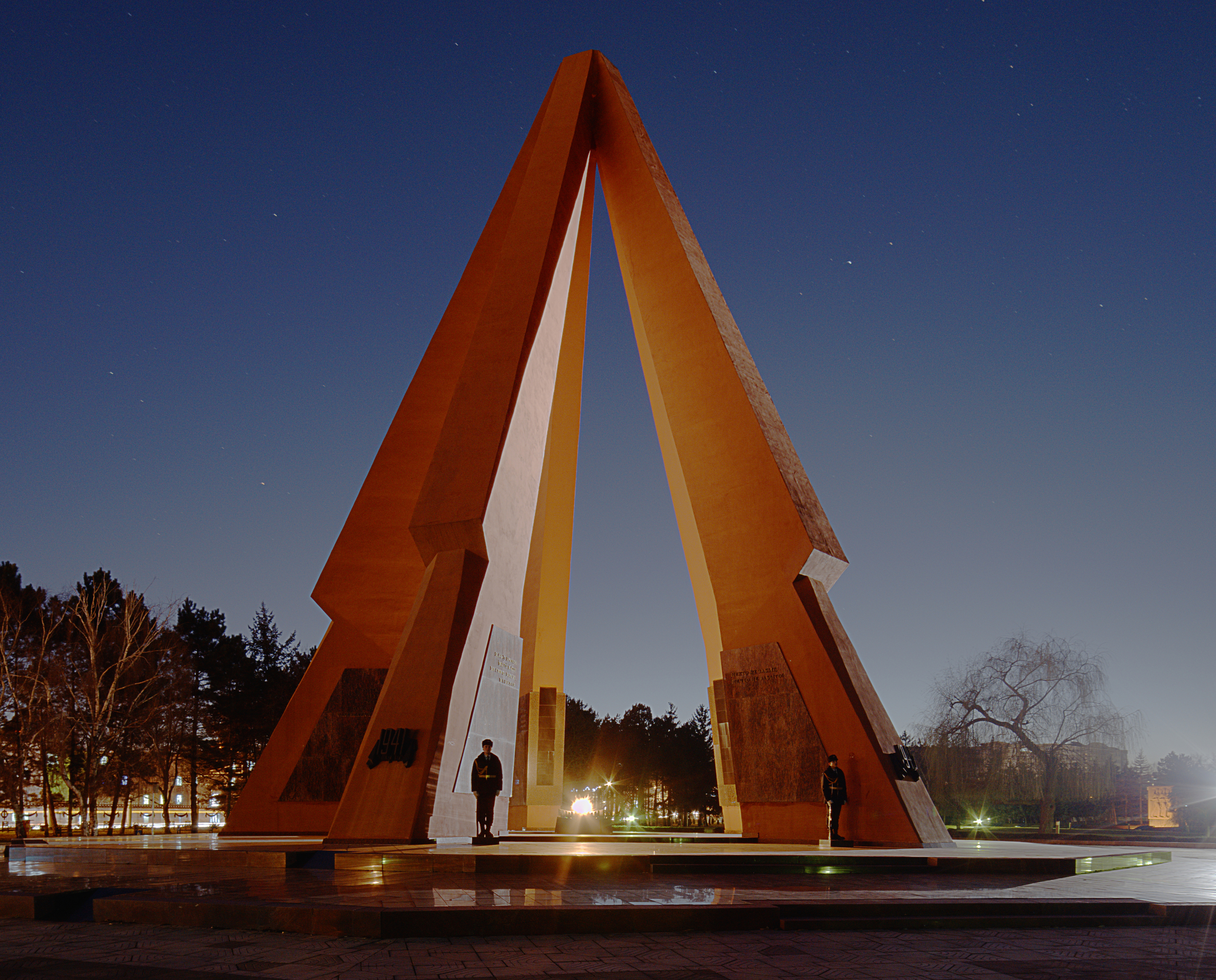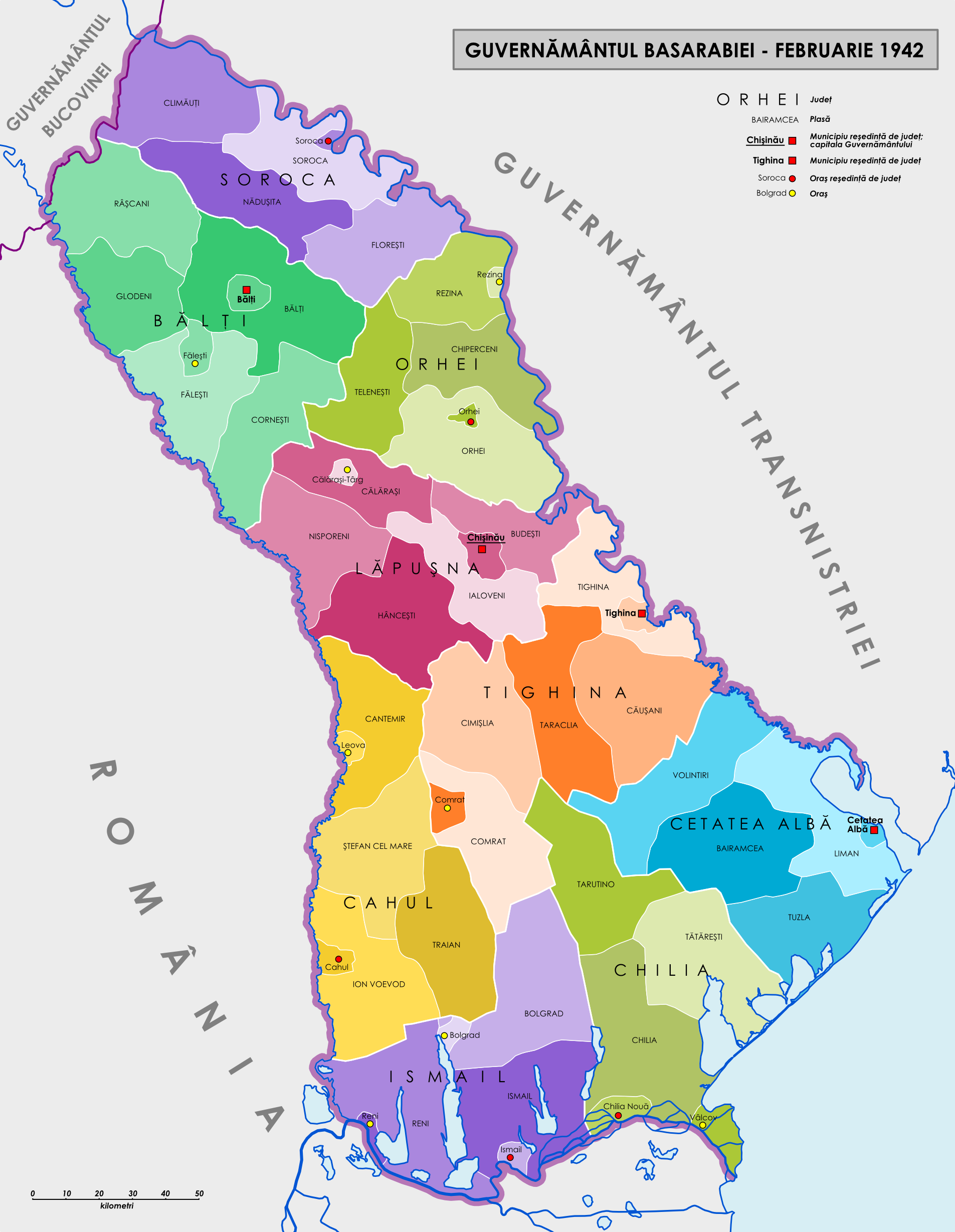|
Administrative Divisions Of The Kingdom Of Romania (1941–1944)
This article discusses the administrative divisions of the Kingdom of Romania between 1941 and 1944. As a result of the Soviet occupation of Bessarabia and Northern Bukovina (28 June-4 July 1940), Second Vienna Award (30 August 1940) and the Treaty of Craiova (7 September 1940), territories that had previously been part of Romania were lost to the Soviet Union, Kingdom of Hungary (1920–1946), Hungary and Bulgaria respectively. By September 1940 the administrative system set up in 1938 based on 'ținuturi' (regions) was disbanded and the former counties (județe) were reintroduced. In 1941, the Romanian participation in the Operation Barbarossa, invasion of the Soviet Union led to the recovery of Bessarabia and Northern Bukovina. Transnistria Governorate, Transnistria, a former Soviet territory between the Dniester and the Southern Bug, with the major Black Sea port of Odessa, was occupied by the Romanian Land Forces, Romanian Army in the autumn of 1941 and was kept under Romanian ... [...More Info...] [...Related Items...] OR: [Wikipedia] [Google] [Baidu] |
Administrative Division
Administrative divisions (also administrative units, administrative regions, subnational entities, or constituent states, as well as many similar generic terms) are geographical areas into which a particular independent sovereign state is divided. Such a unit usually has an administrative authority with the power to take administrative or policy decisions for its area. Administrative divisions are often used as polygons in geospatial analysis. Description Usually, sovereign states have several levels of administrative division. Common names for the principal (largest) administrative divisions include: Federated state, states (subnational states, rather than sovereign states), provinces, States of Germany#States, lands, oblasts and Region#Administrative regions, regions. These in turn are often subdivided into smaller administrative units known by names such as comarcas, raions or districts, which are further subdivided into municipality, municipalities, Commune (administrativ ... [...More Info...] [...Related Items...] OR: [Wikipedia] [Google] [Baidu] |
Județ
A (, plural ) is an administrative division in Romania, and was also used from 1940 to 1947 in the Moldavian Soviet Socialist Republic and from 1998 to 2003 in Moldova. There are 41 in Romania, divided into municipii (municipalities), ''orașe'' (cities) and ''comune'' (communes). Each has a county seat (''reședință de județ'') which serves as its administrative capital; this designation usually belongs to the largest and most developed city in the respective county. The central government is represented by one prefect in every . The capital, Bucharest, is not a , but a special municipality with identical functions, which also acts as the county seat of Ilfov. Etymology In the Romanian Principalities, the was an office with administrative and judicial functions, corresponding to both judge and mayor. The word is etymologically rooted in the Latin "judicium", and is therefore cognate to other administrative institutions like the Sardinian '' giudicati'', or terms lik ... [...More Info...] [...Related Items...] OR: [Wikipedia] [Google] [Baidu] |
ROMANIA MAI 1942
Romania is a country located at the crossroads of Central, Eastern and Southeast Europe. It borders Ukraine to the north and east, Hungary to the west, Serbia to the southwest, Bulgaria to the south, Moldova to the east, and the Black Sea to the southeast. It has a mainly continental climate, and an area of with a population of 19 million people. Romania is the twelfth-largest country in Europe and the sixth-most populous member state of the European Union. Europe's second-longest river, the Danube, empties into the Danube Delta in the southeast of the country. The Carpathian Mountains cross Romania from the north to the southwest and include Moldoveanu Peak, at an altitude of . Bucharest is the country's largest urban area and financial centre. Other major urban areas include Cluj-Napoca, Timișoara, Iași, Constanța and Brașov. Settlement in the territory of modern Romania began in the Lower Paleolithic, later becoming the Dacian Kingdom before Roman conquest and Rom ... [...More Info...] [...Related Items...] OR: [Wikipedia] [Google] [Baidu] |
Raion
A raion (also spelt rayon) is a type of administrative unit of several post-Soviet states. The term is used for both a type of subnational entity and a division of a city. The word is from the French (meaning 'honeycomb, department'), and is commonly translated as ' district' in English. A raion is a standardized administrative entity across most of the former Soviet Union and is usually a subdivision two steps below the national level, such as a subdivision of an oblast. However, in smaller USSR republics, it could be the primary level of administrative division. After the fall of the Soviet Union, some of the republics kept the ''raion'' (e.g. Azerbaijan, Belarus, Ukraine, Russia, Moldova, Kazakhstan, Kyrgyzstan) while others dropped it (e.g. Georgia, Uzbekistan, Estonia, Latvia, Armenia, Tajikistan, Turkmenistan). In Bulgaria, it refers to an internal administrative subdivision of a city not related to the administrative division of the country as a whole, or, in the ca ... [...More Info...] [...Related Items...] OR: [Wikipedia] [Google] [Baidu] |
Tiraspol
Tiraspol (, ; also /; , ; , ) is the capital and largest city of Transnistria, a breakaway state of Moldova, where it is the third-largest city. The city is located on the eastern bank of the Dniester River. Tiraspol is a regional hub of culture, economy, tourism, and light industry, such as furniture and electrical goods production. The modern city of Tiraspol was founded by the Russian generalissimo Alexander Suvorov in 1792, although the area had been inhabited for thousands of years by varying ethnic groups. The city celebrates its anniversary every year on 14 October. Etymology The toponym consists of two ancient Greek words: , ''Tyras'', the Classical antiquity, Ancient name for the Dniester River, and ''polis'', i.e., a city (state). History Classical and medieval history Tyras (), also spelled ''Tiras'', was a Greek colonisation, colony of the Greek city Miletus, probably founded about 600 BC, situated some from the mouth of the Tiras River (Dniester). Of n ... [...More Info...] [...Related Items...] OR: [Wikipedia] [Google] [Baidu] |
Chișinău
Chișinău ( , , ; formerly known as Kishinev) is the Capital city, capital and List of cities and towns in Moldova, largest city of Moldova. The city is Moldova's main industrial and commercial centre, and is located in the middle of the country, on the river Bîc, a tributary of the Dniester. According to the results of the 2014 Moldovan census, 2014 census, the city proper had a population of 532,513, while the population of the Municipality of Chișinău (which includes the city itself and other nearby communities) was 700,000. Chișinău is the most economically prosperous locality in Moldova and its largest transportation hub. Nearly a third of Moldova's population lives in the metro area. Moldova has a Moldovan wine, history of winemaking dating back to at least 3,000 BCE. As the capital city, Chișinău hosts the yearly national wine festival every October. Though the city's buildings were badly damaged during the World War II, Second World War and earthquakes, a rich a ... [...More Info...] [...Related Items...] OR: [Wikipedia] [Google] [Baidu] |
Bessarabia Governorate (Romania)
The Bessarabia Governorate () was an administrative unit of Kingdom of Romania, Romania during World War II. Background and history In 1812, the region of Bessarabia, lying between the Prut and Dniester rivers and historically part of the principality of Moldavia, was annexed by the Russian Empire. This marked the start of a strong process of Russification and colonization of Bessarabia which severely dwindled the presence of the Romanian population. If in 1817 Moldavians were 86% of the population, in 1897 they were only 56%. Previously, Moldavia had also lost the region of Bukovina, annexed in 1775 by the Austrian Habsburg monarchy. In 1859, this country Unification of Moldavia and Wallachia, united with another Romanian principality, Wallachia, creating United Principalities of Moldavia and Wallachia, the first modern Romanian state. Later, in 1917, during World War I to which Kingdom of Romania, Romania had joined in order to gain several Romanian-populated regions, the Russ ... [...More Info...] [...Related Items...] OR: [Wikipedia] [Google] [Baidu] |
Cernăuți
Chernivtsi (, ; , ;, , see also #Names, other names) is a city in southwestern Ukraine on the upper course of the Prut River. Formerly the capital of the historic region of Bukovina, which is now divided between Romania and Ukraine, Chernivtsi serves as the administrative center for the Chernivtsi urban hromada, the Chernivtsi Raion, and the Chernivtsi Oblast, oblast itself. The Chernivtsi population is and the latest Ukrainian Census (2001), census in 2001 was 240,600. The first document that refers to this city dates back to 1408, when Chernivtsi was a town in the region of Moldavia, formerly as a defensive fortification, and became the center of Bukovina in 1488. In 1538, Chernivtsi was under the control of the Principality of Moldavia under Crown of the Kingdom of Poland, Polish suzerainty, later under Ottoman Empire suzerainty, and the Moldavian control lasted for two centuries until 1774, when Archduchy of Austria, Austria took control of Bukovina in the aftermath of t ... [...More Info...] [...Related Items...] OR: [Wikipedia] [Google] [Baidu] |
Bukovina Governorate
The Bukovina Governorate () was an administrative unit of Romania during World War II. Background and history In 1775, the region of Bukovina, historically part of the Romanian principality of Moldavia, officially became part of the Austrian Habsburg monarchy after having invaded it one year earlier, which would start a strong process of Ukrainization. Years later, in 1812, Moldavia also lost Bessarabia to the Russian Empire. In 1859, Moldavia united with another Romanian principality, Wallachia, creating the first modern Romanian state. During World War I, Romania was promised the obtaining of, among other territories, Bukovina as a condition for entering the war. It ended in victory for the country, and Bukovina declared unification with Romania on 28 November 1918. The earlier incorporation of another territory, Bessarabia, into Romania, strained relations between the country and the newly-formed Soviet Union (USSR). Romania tried to defend and secure its new borders duri ... [...More Info...] [...Related Items...] OR: [Wikipedia] [Google] [Baidu] |
Bucharest
Bucharest ( , ; ) is the capital and largest city of Romania. The metropolis stands on the River Dâmbovița (river), Dâmbovița in south-eastern Romania. Its population is officially estimated at 1.76 million residents within a greater Bucharest metropolitan area, metropolitan area of 2.3 million residents, which makes Bucharest the List of cities in the European Union by population within city limits, 8th most-populous city in the European Union. The city area measures and comprises 6 districts (''Sectors of Bucharest, Sectoare''), while the metropolitan area covers . Bucharest is a major cultural, political and economic hub, the country's seat of government, and the capital of the Muntenia region. Bucharest was first mentioned in documents in 1459. The city became the capital in 1862 and is the centre of Romanian media, culture, and art. Its architecture is a mix of historical (mostly History of architecture#Revivalism and Eclecticism, Eclectic, but also Neoclassical arc ... [...More Info...] [...Related Items...] OR: [Wikipedia] [Google] [Baidu] |
Pretor
''Praetor'' ( , ), also ''pretor'', was the title granted by the government of ancient Rome to a man acting in one of two official capacities: (i) the commander of an army, and (ii) as an elected ''magistratus'' (magistrate), assigned to discharge various duties. The functions of the magistracy, the ''praetura'' (praetorship), are described by the adjective itself: the ''praetoria potestas'' (praetorian power), the ''praetorium imperium'' (praetorian authority), and the ''praetorium ius'' (praetorian law), the legal precedents established by the ''praetores'' (praetors). ''Praetorium'', as a substantive, denoted the location from which the praetor exercised his authority, either the headquarters of his ''castra'', the courthouse (tribunal) of his judiciary, or the city hall of his provincial governorship. The minimum age for holding the praetorship was 39 during the Roman Republic, but it was later changed to 30 in the early Empire. History of the title The status of the ''praet ... [...More Info...] [...Related Items...] OR: [Wikipedia] [Google] [Baidu] |




